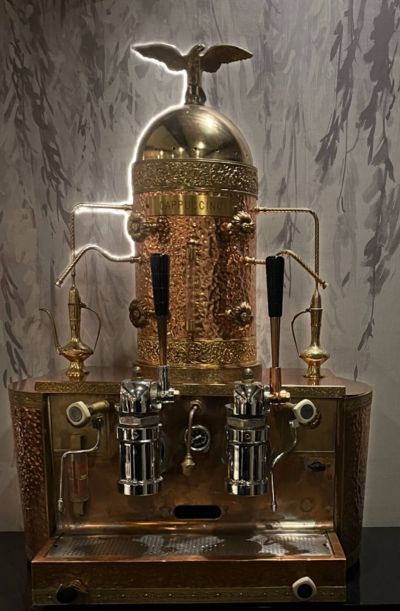Italian coffee culture is one of quality, tradition, and passion. Since coffee beans were first imported into Italy through Venice in the 16th century, the love of coffee began. Italy remains one of the largest importers of beans through its two ports, Trieste and Genoa. There are 700 coffee roaster businesses. Approximately one-third of the beans are blended and packaged to be exported around the world.
It became essential to produce the best coffeemakers who brew the perfect cup, whether commercially or domestically. Italian coffeemakers embody centuries of tradition in engineering and craftsmanship.
The 5 M’s of espresso are as follows: Miscela, the blend of coffee, Macinazione, the grinder or a macinadosatore-doser/grinder, Macchina, the machine, Mano, the skill of the barista, and Manutenzione, machine maintenance. Brew ratio, brew time, and brew temperature are the three variables which affect the taste of the espresso. A firm crema on top, a full body, and an intense aroma through speedy preparation, is the goal.
It was fascinating to find out that the Caffettiera Napoletana or cuccumella was actually invented in 1819 by a Frenchman. This coffeemaker was originally made from copper until 1886 when it was switched to aluminium. It was very popular in Italy until the 20th century. Unlike the Moka pot, this does not use the pressure of steam but rather the force of gravity. It consists of three parts, a top with a spout, a middle for the grounds, and a bottom half that’s filled with water. Once the water boils, you remove it from the heat, turn the whole thing upside down, and allow the water to filter through the grounds into the half that is now on the bottom. In three minutes it will be ready to pour. This method makes a stronger coffee than an automatic drip machine and it’s smoother than the Moka or espresso.
In the late 19th century, the coffee machines were steam-driven to brew the fine, compacted grounds with very hot water, under very high pressure. Angelo Moriondo invented and patented a steam-powered coffeemaking machine in Turin in 1884. It optimized the extraction process to quickly make coffee in bulk for his family’s bars but was never mass-produced.
Luigi Lavazza founded the Lavazza Company in 1895 in Turin. It remains one of the most famous brands with its bold ad campaigns such as, “Caffe Lavazza, piu lo mandi giu e piu ti tira su”, “Lavazza coffee, the more you get it down, the more it lifts you up.”
Luigi Bezzera, in 1901 in Milan, patented improvements on Moriondo’s machine, creating the first true “bar” machine which could make up to 100 cups per day. In 1905, Desiderio Pavoni bought Bezzera’s patent and started mass-producing La Pavoni.' Coffeemaker design was progressing from manual lever machines to semi-automatic and eventually, fully automatic models.
Pier Teresio Arduino of Turin was an engineer and inventor with a passion for coffee. In 1905 he used an innovative approach to espresso machine design to blend traditional craftsmanship with advanced, modern technology. The most notable machine is the Victoria Arduino, VA388 Black Eagle, whose aesthetic appeal with its copper and brass pillars and ornamental eagles and angels became a symbol of elegance.
Alfonso Bialetti invented the Moka Express aluminium coffee pot and patented it in 1933. This pot has two parts plus a filter for the grounds. Placed over heat, the pressure of the water vapor (about one atmosphere) pushes the water from the bottom part up through the grounds in the middle filter and into the top half. La Moka’s unique octagonal design, with the mustached man whose arm and finger point upward, remains a classic to this day. It produces stronger coffee than a drip machine but milder than the espresso machine.
Giovanni Achille Gaggia invented the first modern steamless machine and patented it in 1938. He overcame the possibility of burning the coffee, which would make it bitter, by employing a piston mechanism. This mechanism forces water over the grounds at a high pressure in 15 seconds and produces the crema on top. The crema forms from the natural oils creating an intense flavor. Gaggia’s company went from commercial-use machines into the domestic market in 1977.
In 1947, Giorgio Ponti, architect and industrial designer, designed one of the first horizontal-style machines, La Cornuta which was produced by the Pavoni Co. The traditional Italian cafes use the large, ornate machines which are operated by skilled baristas. They are able to individualize coffee to suit. This is done through adjustments made on the grind size, the tamp pressure, and the extraction time. Students at the University of Coffee, based in Trieste and owned by ILLY, learn to refine these skills.
Giovanni’s Ristorante in Beachwood, OH has what looks to be a magnificent antique steam-powered espresso machine on display.
Whether it is from the simple Moka pot in your home or the fanciest espresso machine in an elegant restaurant, a casual cafe, or even standing up at the bar, you can embrace the art of Italian coffeemaking, and with every sip you will have a taste of Italy.
https://www.lagazzettaitaliana.com/history-culture/10417-la-cultura-del-caffe-coffee-culture#sigProId22f1eabf8c




